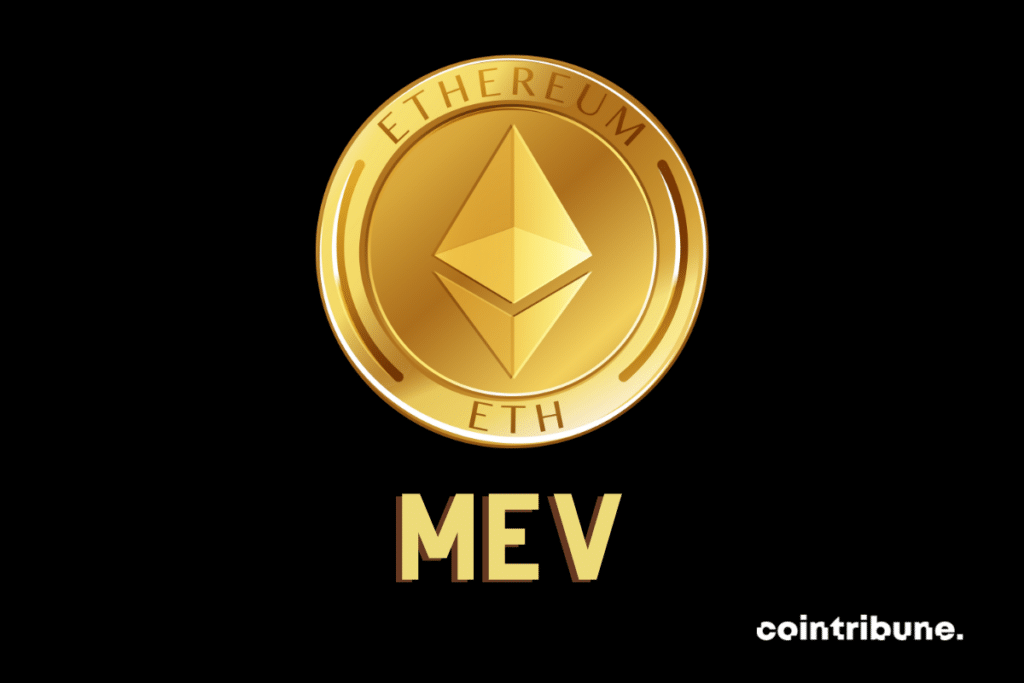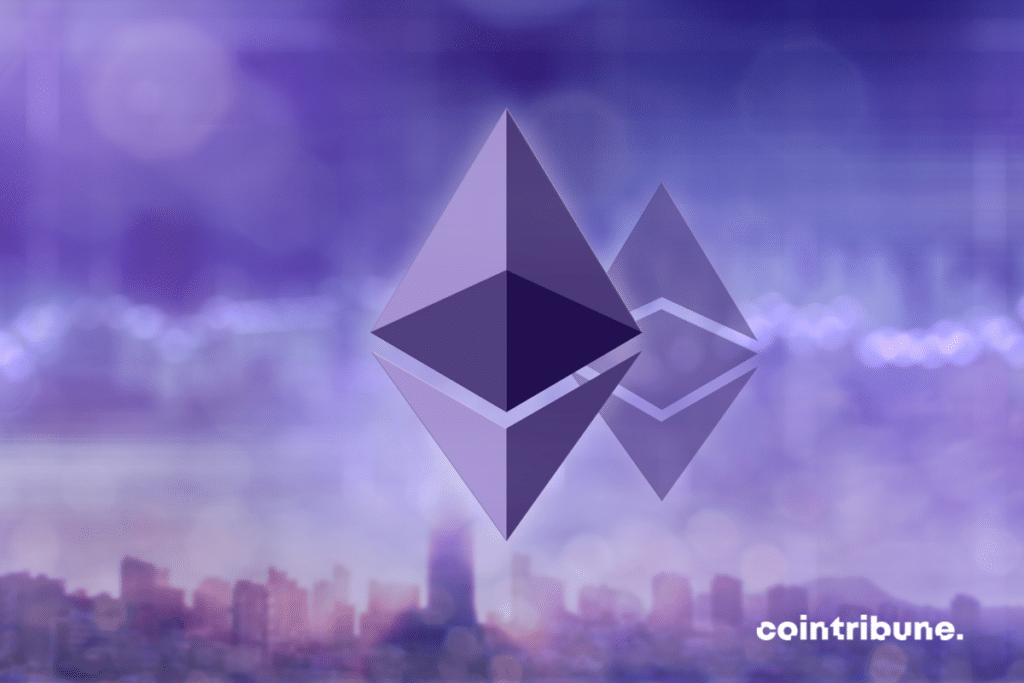MEV (Maximum Extractable Value): What is it?
In the dynamic world of blockchain and cryptocurrencies, the concept of Maximum Extractable Value (MEV) has emerged as an essential topic of discussion. This complex yet crucial phenomenon influences how transactions are processed and secured on blockchain networks, particularly Ethereum. MEV Bots are also gaining popularity. While MEV offers profit opportunities, it also raises questions of fairness and security. This article explores in detail how MEV works, its implications, its interaction with Ethereum 2.0, and its role in decentralized finance (DeFi).

MEV: What is it exactly?
Maximum Extractable Value (MEV) is a crucial concept in the universe of blockchain and cryptocurrencies. It refers to the maximum value that an actor, such as a miner or a validator, can extract from transactions on a blockchain beyond the standard block rewards. This practice, although complex, has become an indispensable element of the Ethereum ecosystem, significantly influencing how transactions are processed.
How does MEV work?
Maximum Extractable Value (MEV) is an essential concept in the blockchain world, particularly for Ethereum. It represents the maximum value an actor can extract from transactions by manipulating the order of blocks. Here’s how MEV works!
Transaction selection and order
Miners or validators, in their quest to maximize MEV, control the transactions to include in a block. By selecting transactions with higher fees, they can increase their profits. This selection is not random but based on a meticulous analysis of the pending transaction pool. Actors analyze the market using tools and algorithms to identify the most profitable transactions. This ability to prioritize certain transactions over others raises questions of fairness and transparency in processing operations on the blockchain.
Value extraction strategies
The strategies to extract maximum value vary. Front-running is a common practice where a miner places their own transaction before a known lucrative transaction. Back-running, on the other hand, involves placing transactions immediately after a major transaction to profit from its market effects. These strategies require an advanced understanding of how transactions work on the blockchain and the ability to predict market movements. Miners and validators use complex algorithms and monitoring tools to identify these opportunities in real-time.
Ethical and technical implications
MEV poses ethical and technical challenges. Ethically, it creates an uneven playing field where miners with advanced resources and knowledge can dominate. Technically, it can lead to network congestion as miners prioritize certain transactions over others. Moreover, it can affect the predictability and reliability of transactions, a crucial aspect for trust in blockchain systems. The Ethereum community and other blockchain networks continue to seek solutions to balance the benefits of MEV with the need for a fair and secure system.
The implications of MEV
Maximum Extractable Value (MEV) has significant repercussions on the blockchain ecosystem, particularly for networks like Ethereum. While MEV offers profit opportunities for some actors, it also raises important questions about security, fairness, and centralization in blockchain networks.
Impact on blockchain network security
MEV can substantially influence the security of blockchain networks. On one hand, it provides miners with an additional financial incentive, which can enhance overall network security by attracting more computing power. However, this incentive can also lead to opportunistic behaviors. Miners or validators might prioritize certain transactions or delay others, compromising the network’s integrity and reliability. Additionally, MEV practices can make the network vulnerable to censorship attacks, where powerful miners could choose to censor certain transactions to maximize their profits. This situation poses a serious risk to the decentralized and open nature of blockchains, a fundamental pillar of their security and reliability.
Consequences on fairness and accessibility
MEV also impacts fairness and accessibility in the blockchain ecosystem. Users who lack the tools or knowledge to understand or exploit MEV may find themselves disadvantaged. For example, in the case of front-running, ordinary users can incur financial losses when their transactions are pre-empted by more informed or faster actors.
This situation creates an imbalance where only the best-equipped participants can fully benefit from the opportunities offered by MEV. Furthermore, it can lead to increased transaction fees for all users, as competition for inclusion in blocks intensifies. These dynamics can make blockchain networks less accessible and less attractive to a broader audience, counteracting the ideal of financial democratization promoted by blockchain technology.
Effects on centralization and blockchain culture
Finally, MEV can contribute to increased centralization within blockchain networks. Miners or mining pools with substantial resources and advanced technical capabilities are better positioned to exploit MEV, which can lead to a concentration of power among a few dominant actors. This centralization runs counter to the spirit of decentralization and equal opportunity at the heart of blockchain technology. It also raises questions about the resilience and robustness of blockchain networks against external influences and malicious actors. Additionally, this centralization can affect public perception and trust in cryptocurrencies and blockchain in general, which is crucial for their adoption and integration into daily life and internet services.

MEV and Ethereum 2.0
With the advent of Ethereum 2.0, the landscape of Maximum Extractable Value (MEV) is undergoing a significant transformation. Ethereum 2.0, marking the transition from a Proof-of-Work (PoW) to a Proof-of-Stake (PoS) consensus mechanism, brings fundamental changes that directly affect the dynamics of MEV. In PoS, validators replace miners for block creation, altering how MEV is generated and distributed. This transition aims to reduce opportunities for transaction manipulation and improve network fairness and security.
In PoW, miners could prioritize transactions based on fees, creating fertile ground for MEV. With PoS, however, the selection of validators for block creation is more random and less influenced by computing power, reducing actors’ ability to manipulate transaction order for their own benefit. Additionally, Ethereum 2.0 introduces mechanisms like “sharding,” which aims to increase network capacity and reduce congestion, thereby limiting MEV opportunities related to transaction speed. These changes are crucial for creating a more balanced and secure environment, where extractable value is less concentrated in the hands of a few dominant actors.
However, it is important to note that MEV will not completely disappear with Ethereum 2.0. Validators, although subject to a more random selection process, will still have the ability to influence transaction order to some extent. The Ethereum community continues to seek solutions to minimize the negative impacts of MEV while preserving the positive aspects of this practice, such as the incentive to maintain network security and performance.
MEV and DeFi
In the world of decentralized finance (DeFi), Maximum Extractable Value (MEV) plays a crucial role, particularly with the emergence of DeFi 2.0. DeFi 2.0, characterized by more sophisticated protocols and deeper integration with blockchain systems, opens new dimensions for MEV. The complex interactions between different DeFi protocols, such as decentralized exchanges (DEX) and lending platforms, create unprecedented opportunities for value extraction. DeFi actors, armed with advanced strategies and technical knowledge, can exploit these opportunities to maximize their gains. This includes techniques like front-running on transaction orders or exploiting price differences between various DeFi platforms.
However, this dynamic also raises concerns about security and fairness for ordinary users. MEV in DeFi 2.0 can lead to an unequal user experience, where less informed participants are disadvantaged compared to more sophisticated actors. To address these challenges, many DeFi 2.0 protocols are incorporating measures to mitigate the impact of MEV, such as protection mechanisms against front-running and improved pricing algorithms. These initiatives aim to preserve transaction integrity and ensure a fairer experience for all users. Ultimately, MEV remains an essential aspect of DeFi 2.0, requiring constant attention to balance profit opportunities with system security and fairness.
Maximum Extractable Value (MEV) is a fundamental and influential element in the blockchain ecosystem, particularly for Ethereum and DeFi. While initiatives like Ethereum 2.0 aim to mitigate its effects, MEV remains a determining factor in the management and security of transactions. It raises important questions of fairness and security, requiring constant attention and innovation. Understanding MEV is therefore indispensable for anyone engaging in the world of cryptocurrencies.
Maximize your Cointribune experience with our "Read to Earn" program! For every article you read, earn points and access exclusive rewards. Sign up now and start earning benefits.
Diplômé de Sciences Po Toulouse et titulaire d'une certification consultant blockchain délivrée par Alyra, j'ai rejoint l'aventure Cointribune en 2019. Convaincu du potentiel de la blockchain pour transformer de nombreux secteurs de l'économie, j'ai pris l'engagement de sensibiliser et d'informer le grand public sur cet écosystème en constante évolution. Mon objectif est de permettre à chacun de mieux comprendre la blockchain et de saisir les opportunités qu'elle offre. Je m'efforce chaque jour de fournir une analyse objective de l'actualité, de décrypter les tendances du marché, de relayer les dernières innovations technologiques et de mettre en perspective les enjeux économiques et sociétaux de cette révolution en marche.
The views, thoughts, and opinions expressed in this article belong solely to the author, and should not be taken as investment advice. Do your own research before taking any investment decisions.